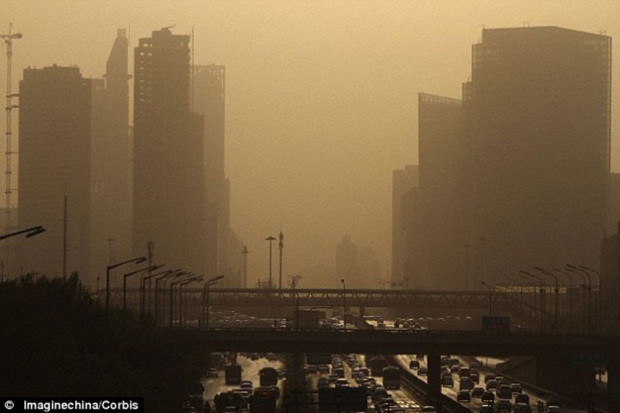
Knowledge | Posted by Zarni Kyaw
China’s environmental woes are common knowledge to most of the world; take a trip to Beijing and you’ll quickly see the effects deforestation can have on a city’s way of life.
There, toxic dust clouds and high levels of pollution threaten the lives of people on almost a daily basis.
But the Chinese government has an ambitious plan to improve conditions.
For several decades they have been planting a ‘great wall of trees’ to block the impacts from the Gobi Desert - and a study says the measures are working, despite previous criticism.

(China is planting huge strips of trees to stop the Gobi Desert (illustration shown). For decades the desert has been advancing and causing serious dust storms to key cities such as Beijing. Since 1978 the government has been planting trees to reverse the widespread deforestation that took place in China)
The Three-North Shelter Forest Programme, more commonly known as the Great Green Wall (GGW), is a series of huge forest strips designed to hold back the expansion of the Gobi Desert.
Every spring the country is subjected to devastating sand storms as winds sweep down from the North, bringing the Gobi Desert with them.
And as the desert expands - partly due to human deforestation to make room for agriculture, livestock and mining - the situation had the potential of getting worse and worse.
In 1978, though, China made a bold decision to begin the GGW project - and it seems they are now beginning to reap the benefits of that decision.
By 2006, 25 million hectares of forest were growing. By 2050, more than 100 billion trees will occupy a 2,800-mile (4,500km) belt, 1.6 million squre miles (4.1 million square km), more than a tenth of the country.
And some think that planting trees in the sandy ground of the Gobi Desert will not work, with the mortality rate of the trees being unknown.
This means the longevity of the project has been called into question, with continual replanting of trees required long into the future to maintain their effectiveness.
But the latest study, led by Dr Minghong Tan from the Chinese Academy of Sciences, says the measures are working - and they will continue to do so.
 (Every spring some of China's cities, such as Beijing (shown on 9 April 2014), are ravaged by dust storms that make their way South from the Gobi desert. It is hoped that the Great Green Wall project will improve the quality of life for the people living in cities like this)
(Every spring some of China's cities, such as Beijing (shown on 9 April 2014), are ravaged by dust storms that make their way South from the Gobi desert. It is hoped that the Great Green Wall project will improve the quality of life for the people living in cities like this)

(Pictured are workers planting part of the shelterbelt at the Mu Us Desert of Baijitan shelterbelt forest in Wuling City, northwest China's Ningxia Hui Autonomous Region, on 23 July 2013. China launched the Three-North Shelterbelt Forest Program in 1978 as an anti-desertification effort)
The results show that in the GGW region, vegetation has greatly improved, while it varied dramatically outside the GGW region,’ the researchers write in their paper.

(This photo taken on 27 July 2013 shows the shelterbelt forest at the Sanjiang Plain, northeast China's Heilongjiang Province. State Forestry Administration (SFA) data showed that the forest coverage in the treated areas had increased to 12.4 per cent at the end of 2012 from 5.05 per cent in 1977)
Ref: Will China's Great GREEN Wall save the country from dust storms? 100 billion tree project could halt advancing Gobi Desert (dailymail)
Photo Credit-Dailymail









